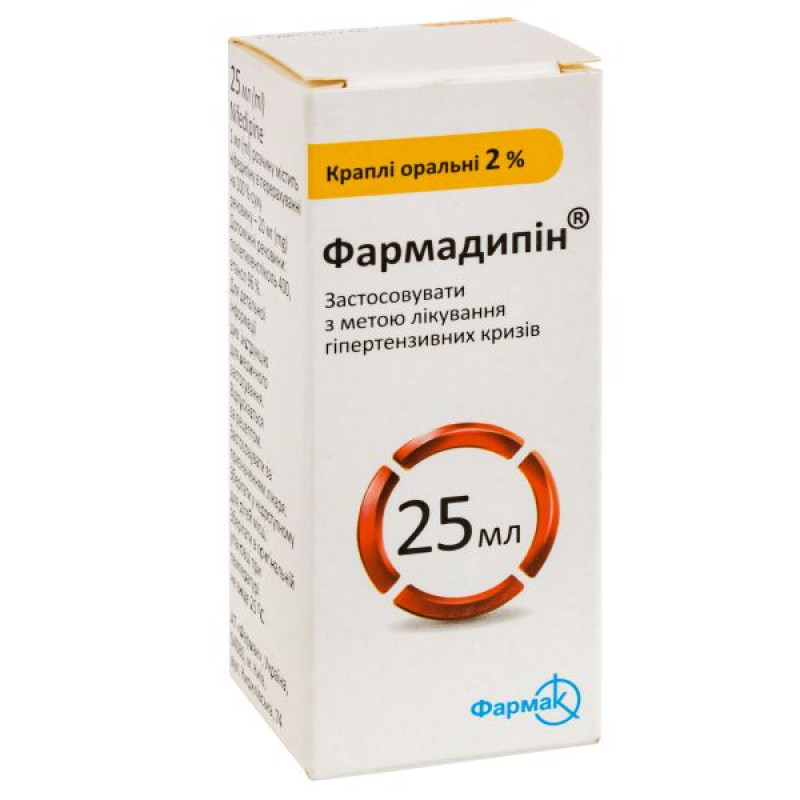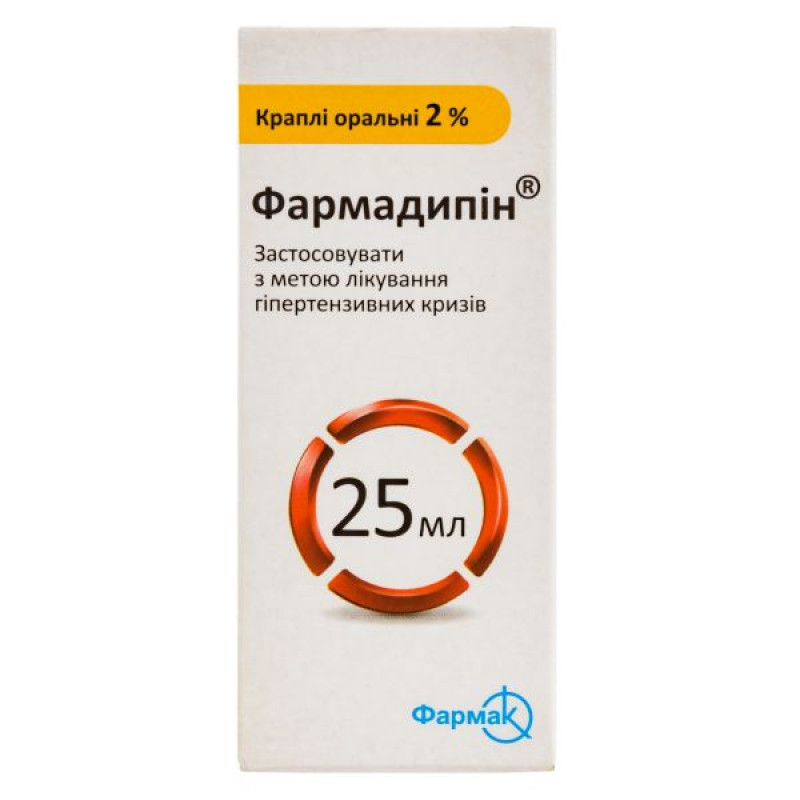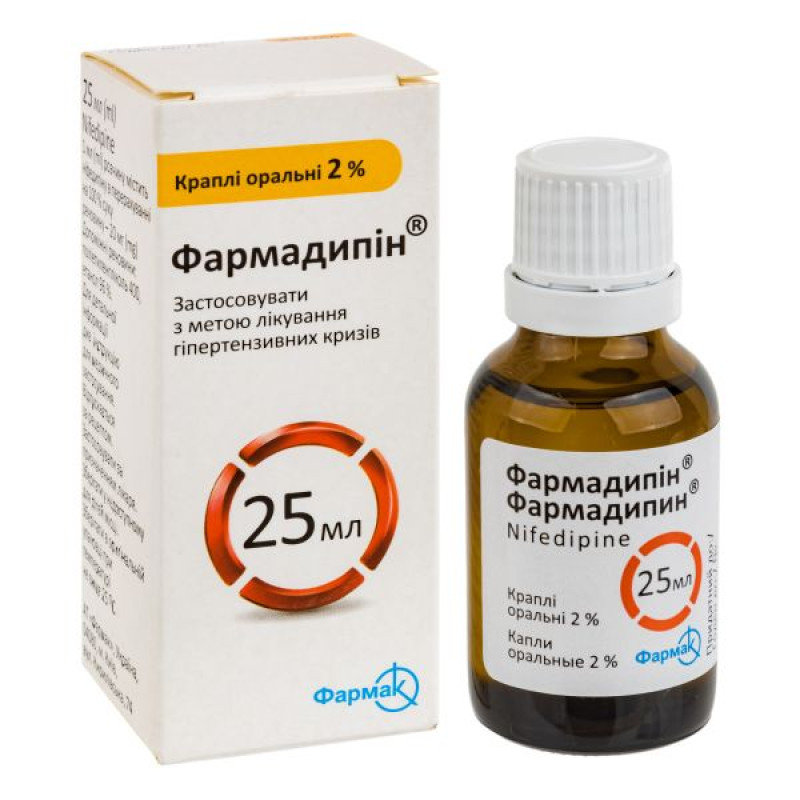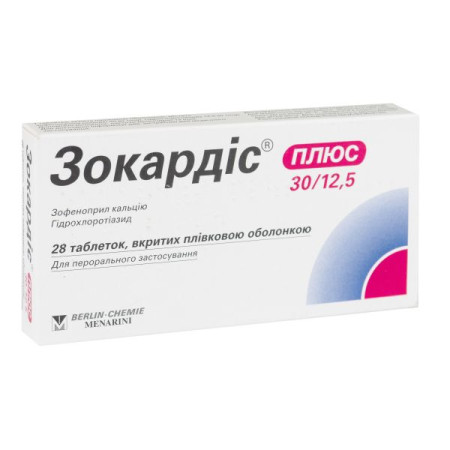Farmadipin oral drops 2% bottle 25 ml

Instructions for Pharmadipin oral drops 2% bottle 25 ml
Composition
active ingredient: nifedipine;
1 ml of solution contains nifedipine in terms of 100% dry matter 20 mg (30 drops);
excipients: polyethylene glycol 400, ethanol 96%.
Dosage form
Oral drops.
Main physicochemical properties: transparent yellow or greenish-yellow viscous liquid with a faint alcohol odor.
Pharmacotherapeutic group
Selective calcium antagonists with predominant vascular effects. ATC code C08C A05.
Pharmacological properties
Pharmacodynamics
Farmadipin® exhibits antianginal and antihypertensive effects. Blocks the influx of calcium ions into cardiomyocytes and smooth muscle cells of the coronary and peripheral arteries through slow voltage-dependent calcium channels of cell membranes. Relaxes vascular smooth muscle, eliminates spasms and dilates coronary and peripheral arteries, reducing peripheral vascular resistance, blood pressure, afterload and myocardial oxygen demand; slightly reduces myocardial contractility, slightly reduces platelet aggregation.
Pharmacokinetics
When taken orally, it is well absorbed from the digestive tract, bioavailability is 40-60%. The effect develops especially quickly (after 5-10 minutes) when taken sublingually. Usually, the maximum effect is recorded after 30-40 minutes. Food intake does not significantly affect the rate of absorption of the drug. The hemodynamic effect persists for 4-6 hours. Up to 90% of nifedipine binds to blood plasma proteins. It is metabolized in the liver and excreted from the body mainly in the form of inactive metabolites. The total clearance of nifedipine is from 0.4 to 0.6 l/kg/h. The half-life is 2-4 hours. In elderly people and patients with liver cirrhosis, the metabolism of nifedipine slows down, so in them the half-life of the drug can be extended by almost 2 times, which requires a dose reduction and an increase in the intervals between doses of the drug. Nifedipine does not accumulate in the body. In small quantities, it crosses the blood-brain and placental barriers and penetrates into breast milk.
Indication
Arterial hypertension (for the treatment of hypertensive crises).
Contraindication
Acute myocardial infarction (within the first 4 weeks); cardiogenic shock; severe aortic and mitral stenosis; unstable angina; do not use for the treatment of angina attacks, secondary prevention of myocardial infarction; decompensated heart failure; arterial hypotension (systolic blood pressure (BP) below 90 mm Hg); ventricular tachycardia with a wide QRS complex; sick sinus syndrome; Wolff-Parkinson-White syndrome (WPW), Laun-Ganong-Levine syndrome (LGL); AV block of II and III degrees; porphyria; ileostomy established after proctocolectomy; hypersensitivity to nifedipine and other components of the drug; hypersensitivity to other dihydropyridines; do not take simultaneously with rifampicin.
Interaction with other medicinal products and other types of interactions
Drugs that affect the effectiveness of nifedipine
Nifedipine is metabolized by the cytochrome P450 3A4 system, which is located in the intestinal mucosa and liver. Therefore, drugs that inhibit or induce this enzyme system may alter the "first pass" (after oral administration) or clearance of nifedipine.
When using nifedipine together with the following drugs, the degree and duration of interaction should be taken into account.
Rifampicin
Rifampicin significantly induces the cytochrome P450 3A4 system. When used simultaneously with rifampicin, the bioavailability of nifedipine is significantly reduced and, thus, its effectiveness is weakened. In view of this, the use of the combination of nifedipine with rifampicin is contraindicated.
When concomitantly using the following weak or moderate inhibitors of the cytochrome P450 3A4 system, blood pressure should be monitored and, if necessary, a reduction in the nifedipine dose should be considered.
Macrolide antibiotics (e.g., erythromycin)
No interaction studies have been conducted between nifedipine and macrolide antibiotics. Certain macrolide antibiotics inhibit the cytochrome P450 3A4-mediated metabolism of other drugs. Therefore, an increase in nifedipine plasma concentrations cannot be excluded when both drugs are administered simultaneously.
Azithromycin, which is structurally similar to members of the macrolide class of antibiotics, does not inhibit CYP3A4.
Anti-HIV protease inhibitors (e.g. ritonavir)
A clinical study investigating the potential for interaction between nifedipine and certain anti-HIV protease inhibitors has not yet been conducted. Drugs of this class are known to inhibit the cytochrome P450 3A4 system. In addition, drugs of this class inhibit the cytochrome P450 3A4-mediated metabolism of nifedipine in vitro. When used concomitantly with nifedipine, a significant increase in nifedipine plasma concentrations cannot be excluded due to a decrease in first-pass metabolism and a decrease in the rate of elimination from the body.
No clinical study has been conducted to investigate the potential for interactions between nifedipine and certain azole antifungals. Drugs of this class are known to inhibit the cytochrome P450 3A4 system. When administered orally with nifedipine, a significant increase in the systemic bioavailability of nifedipine due to a decrease in first-pass metabolism cannot be excluded.
Fluoxetine
A clinical study investigating the possibility of an interaction between nifedipine and fluoxetine has not yet been conducted. Fluoxetine is known to inhibit the cytochrome P450 3A4-mediated metabolism of nifedipine in vitro. An increase in nifedipine plasma concentrations cannot be excluded when both drugs are used simultaneously.
Nefazodone
A clinical study investigating the potential for interaction between nifedipine and nefazodone has not yet been conducted. Nefazodone is known to inhibit the cytochrome P450 3A4-mediated metabolism of other drugs in vitro. An increase in nifedipine plasma concentrations cannot be excluded when both drugs are administered simultaneously.
Quinupristin/dalfopristin
Concomitant use of quinupristin/dalfopristin and nifedipine may lead to increased plasma concentrations of nifedipine.
Valproic acid
No clinical study has been conducted to investigate the potential for interaction between nifedipine and valproic acid. Valproic acid is known to increase the plasma concentration of the structurally similar calcium channel blocker nimodipine due to enzyme inhibition. Therefore, an increase in nifedipine plasma concentration and efficacy cannot be excluded.
Cimetidine
Due to inhibition of cytochrome P450 3A4, cimetidine increases the plasma concentration of nifedipine and may enhance the antihypertensive effect.
Cisapride
Concomitant use of cisapride and nifedipine may lead to an increase in nifedipine plasma concentrations.
Antiepileptic drugs that induce the cytochrome P450 3A4 system, such as phenytoin, carbamazepine, and phenobarbital
Phenytoin induces the cytochrome P450 3A4 system. When used simultaneously with phenytoin, the bioavailability of nifedipine is reduced and the efficacy is weakened. When using both drugs simultaneously, it is necessary to monitor the clinical response to nifedipine therapy and, if necessary, consider increasing the nifedipine dose. In the event of an increase in the nifedipine dose during the simultaneous use of both drugs, when phenytoin is discontinued, a reduction in the nifedipine dose should be considered.
No clinical studies have been conducted to investigate the possibility of a potential interaction between nifedipine and carbamazepine or phenobarbital. Both drugs are known to reduce plasma concentrations of the structurally similar calcium channel blocker nimodipine due to enzyme induction. Therefore, a decrease in nifedipine plasma concentrations and reduced efficacy cannot be excluded.
Antihypertensive drugs
Nifedipine may increase the antihypertensive effect of concomitantly used antihypertensive drugs, such as: diuretics, β-blockers, ACE inhibitors, AT1 receptor antagonists, other calcium antagonists, α-adrenergic blockers, PDE5 inhibitors, α-methyldopa, magnesium sulfate.
When nifedipine is used concomitantly with β-blockers, careful monitoring of the patient is required, as isolated cases of exacerbation of heart failure are known.
Digoxin and theophylline
The combination of nifedipine with digoxin and theophylline is usually well tolerated by patients, very rarely an increase in the level of digoxin and theophylline in the blood plasma is possible (the latter plasma content should be monitored). In this regard, the patient should be monitored for symptoms of digoxin overdose and, if necessary, the dose of the glycoside should be reduced, taking into account the concentration of digoxin in the plasma.
Amiodarone and quinidine
Amiodarone and quinidine may enhance the negative inotropic effect of nifedipine. In some cases, a decrease in quinidine levels has been observed when nifedipine and quinidine are used concomitantly, and a sharp increase in quinidine plasma concentrations has been observed when nifedipine is discontinued. Therefore, it is recommended that quinidine plasma concentrations be monitored during concomitant use or discontinuation of nifedipine, and that the quinidine dose be adjusted if necessary. Some authors have reported an increase in nifedipine plasma concentrations with concomitant use of both drugs, but other authors have not noted any changes in nifedipine pharmacokinetics.
Therefore, blood pressure should be closely monitored when quinidine is added to a nifedipine regimen. If necessary, the nifedipine dose should be reduced.
Tacrolimus
Tacrolimus is known to be metabolised via the cytochrome P450 3A4 system. Published data suggest that in some cases the dose of tacrolimus may need to be reduced when co-administered with nifedipine. Plasma tacrolimus concentrations should be monitored when both drugs are co-administered and a reduction in the tacrolimus dose should be considered if necessary.
Other types of interactions
Grapefruit juice inhibits the cytochrome P450 3A4 system. The use of grapefruit juice with nifedipine leads to an increase in the plasma concentration of the drug and an increase in the duration of action of nifedipine due to a decrease in first-pass metabolism or a decrease in clearance. As a result, the antihypertensive effect of the drug may be enhanced. After regular consumption of grapefruit juice, this effect may persist for at least 3 days after the last intake of the juice.
Therefore, grapefruit/grapefruit juice should be avoided during nifedipine therapy.
The use of nifedipine may lead to falsely elevated results in spectrophotometric determination of the concentration of vanillylmandelic acid in urine (however, this effect is not observed when using the high-performance liquid chromatography method).
Application features
Caution should be exercised when using Farmadipin® in patients with severe narrowing of the gastrointestinal tract due to the possibility of obstructive symptoms. Very rarely, bezoars may occur, which may require surgical intervention.
In isolated cases, obstructive symptoms have been described in the absence of a history of gastrointestinal disorders.
The use of Pharmadipin® may lead to false-positive results in X-ray examinations using barium contrast media (for example, filling defects are interpreted as a polyp).
Patients with impaired liver function require careful monitoring, and in severe cases, a dose reduction.
Nifedipine is metabolized via the cytochrome P450 3A4 system; therefore, drugs that inhibit or induce this enzyme system may alter the "first pass" or clearance of nifedipine.
Drugs that are weak or moderate inhibitors of the cytochrome P450 3A4 system and may lead to increased plasma concentrations of nifedipine include: macrolide antibiotics (e.g. erythromycin), anti-HIV protease inhibitors (e.g. ritonavir), azole antifungals (e.g. ketoconazole), antidepressants nefazodone and fluoxetine, quinupristin/dalfopristin, valproic acid, cimetidine.
When concomitantly using Farmadipin® with these drugs, it is necessary to monitor blood pressure and, if necessary, consider reducing the dose of nifedipine.
The drug should not be used if there is a possible connection between previous use of nifedipine and ischemic pain. In patients with angina pectoris, attacks may occur more frequently, and their duration and intensity may increase, especially at the beginning of treatment.
Medicines with the active ingredient nifedipine are not used in patients with an acute attack of stable angina.
The drug should be administered with special caution to patients on hemodialysis, in conditions of malignant arterial hypertension or hypovolemia, since the expansion of blood vessels can cause a significant decrease in blood pressure in them. The use of nifedipine in patients with diabetes mellitus may require correction of treatment.
This medicine contains a small amount of ethanol (alcohol), less than 100 mg/dose.
Ability to influence reaction speed when driving vehicles or other mechanisms
When using the drug, you should refrain from potentially dangerous activities that require increased attention (driving vehicles and mechanisms, etc.).
Use during pregnancy or breastfeeding
Pregnancy
Nifedipine is contraindicated for use during pregnancy.
Breast-feeding
Nifedipine passes into breast milk, so breastfeeding should be discontinued during use of the drug.
Fertility
Some in vitro experiments have shown an association between the use of calcium antagonists, in particular nifedipine, and reversible biochemical changes in spermatozoa that impair their ability to fertilize. In cases where in vitro fertilization attempts are unsuccessful, in the absence of other explanations, calcium antagonists, such as nifedipine, may be considered as a possible cause of this phenomenon.
Method of administration and doses
Farmadipin® is used for the treatment of hypertensive crises as an emergency drug. It is not recommended to use the drug in this dosage form for course administration.
If it is necessary to conduct a course of antihypertensive therapy, the drug and dosage form are selected by the doctor.
It is necessary to take into account the individual sensitivity of individual patients to Farmadipin®. In such cases, the dose should be selected individually, starting with 3 drops, and gradually increased by 2-3 drops (1.34-2 mg) until the clinical effect is achieved.
Exceeding the initial dose of the drug can lead to a sharp decrease in blood pressure!
Children
The drug should not be used to treat children (under 18 years of age).
Overdose
Symptoms of acute nifedipine intoxication: impaired consciousness up to coma, decreased blood pressure, tachycardia/bradycardia, hyperglycemia, metabolic acidosis, hypoxia, cardiogenic shock accompanied by pulmonary edema.
Treatment. Emergency care measures should primarily be aimed at removing the drug from the body and restoring stable hemodynamics.
After oral administration, it is recommended to completely empty the stomach, if necessary in combination with small bowel lavage.
Elimination of the drug from the body should be as complete as possible, including the small intestine, especially in cases of intoxication with sustained-release nifedipine preparations to prevent absorption of the active substance.
Since nifedipine is characterized by a high degree of binding to plasma proteins and a relatively small volume of distribution, hemodialysis is ineffective, but plasmapheresis is recommended.
Bradycardia can be treated with beta-sympathomimetics. In cases of life-threatening bradycardia, the use of an artificial pacemaker is recommended.
Hypotension resulting from cardiogenic shock and vasodilation can be treated with calcium preparations (10-20 ml of a 10% solution of calcium chloride or gluconate is administered intravenously slowly, then repeated if necessary). As a result, serum calcium levels may reach the upper limit of normal or be slightly elevated. If calcium administration is not effective enough, it is advisable to use sympathomimetics such as dopamine or noradrenaline. The doses of these preparations are selected taking into account the achieved therapeutic effect.
Additional fluid administration should be approached very carefully, as it increases the risk of heart overload.
Adverse reactions
When following the recommendations for using the drug, adverse reactions are minor and reversible, and as a rule do not require discontinuation of therapy.
With frequent and uncontrolled use, possible adverse reactions are typical for drugs of this pharmacological group.
From the blood and lymphatic system: leukopenia, agranulocytosis, anemia, thrombocytopenia.
Immune system disorders: allergic reactions, allergic edema/angioedema (including laryngeal edema*), anaphylactic/anaphylactoid reaction.
Psychiatric disorders: anxiety reactions, agitation, sleep disorders.
Nervous system: headache, vertigo, migraine, dizziness, tremor, hypoesthesia, paresthesia, dysesthesia, drowsiness, loss of consciousness.
Metabolism and metabolism: hyperglycemia (should be considered in patients with diabetes).
On the part of the organs of vision: visual impairment, eye pain.
From the side of the cardiovascular system: tachycardia, palpitations, chest pain (angina pectoris).
Vascular disorders: edema, vasodilation, hypotension.
From the respiratory system: epistaxis, nasal congestion, dyspnea.
Gastrointestinal: constipation, gastrointestinal and abdominal pain, nausea, dyspepsia, flatulence, dry mouth, gingival hyperplasia, bezoar, dysphagia, intestinal obstruction, intestinal ulcer, vomiting, gastroesophageal sphincter insufficiency.
From the liver and biliary tract: transient increase in liver enzyme activity, jaundice.
Skin and subcutaneous tissue disorders: erythema, toxic epidermal necrolysis, photosensitivity, purpura, pruritus, urticaria, rash.
Musculoskeletal, connective tissue and bone disorders: muscle cramps, joint swelling, arthralgia, myalgia.
From the kidneys and urinary tract: polyuria, dysuria.
Reproductive system and breast disorders: erectile dysfunction.
General disorders: malaise, nonspecific pain, fever.
*may lead to life-threatening consequences.
Patients with malignant hypertension and hypovolemia who are on hemodialysis may experience a significant decrease in blood pressure due to vasodilation.
Expiration date
3 years.
Do not use the drug after the expiration date indicated on the package.
Storage conditions
Store in original packaging at a temperature not exceeding 25 ºС.
Keep out of reach of children.
Packaging
25 ml in a bottle. 1 bottle in a pack.
Vacation category
According to the recipe.
Producer
JSC "Farmak".
Location of the manufacturer and its business address
Ukraine, 04080, Kyiv, Kyrylivska St., 74.
There are no reviews for this product.
There are no reviews for this product, be the first to leave your review.
No questions about this product, be the first and ask your question.







